Taxation Law of Australia Assignment - Semester 2, 2019, University
VerifiedAdded on 2022/10/07
|20
|4272
|42
Homework Assignment
AI Summary
This document presents a comprehensive solution to a taxation law assignment focusing on the taxation laws of Australia. The assignment addresses several key areas, including small business entities and relevant tax rulings, and gift deductions. It also delves into the marginal tax rates for Australian residents, capital gains tax on personal assets, and the implications of capital event C1. The assignment further explores the tax-free threshold, the legal precedent set by the Hayes vs FCT case, and the distinction between ordinary and statutory income. It also clarifies the differences between the Medicare Levy and Medicare Levy Surcharge. Additionally, it examines the residency status of individuals under TR 98/17. The solution provides detailed analysis of HECS-HELP deductions, travel expenses, book expenses, and childcare costs, along with relevant legislation and case law such as Finn v FCT and FCT v Lodge, to support the arguments and conclusions. The assignment adheres to the Australian Guide to Legal Citation (AGLC) 4th Edition referencing method and provides an in-depth understanding of the complexities of Australian taxation law.
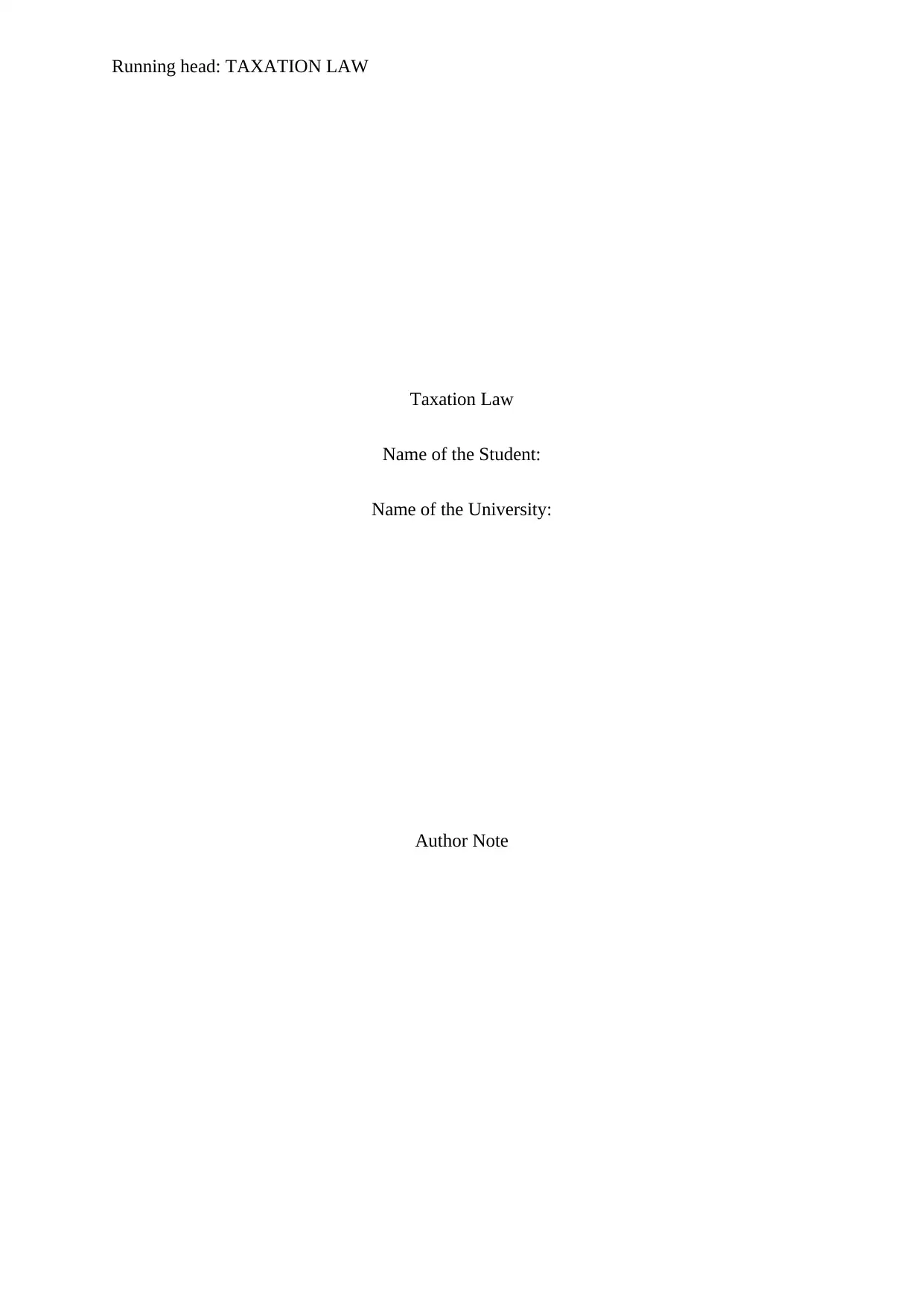
Running head: TAXATION LAW
Taxation Law
Name of the Student:
Name of the University:
Author Note
Taxation Law
Name of the Student:
Name of the University:
Author Note
Paraphrase This Document
Need a fresh take? Get an instant paraphrase of this document with our AI Paraphraser
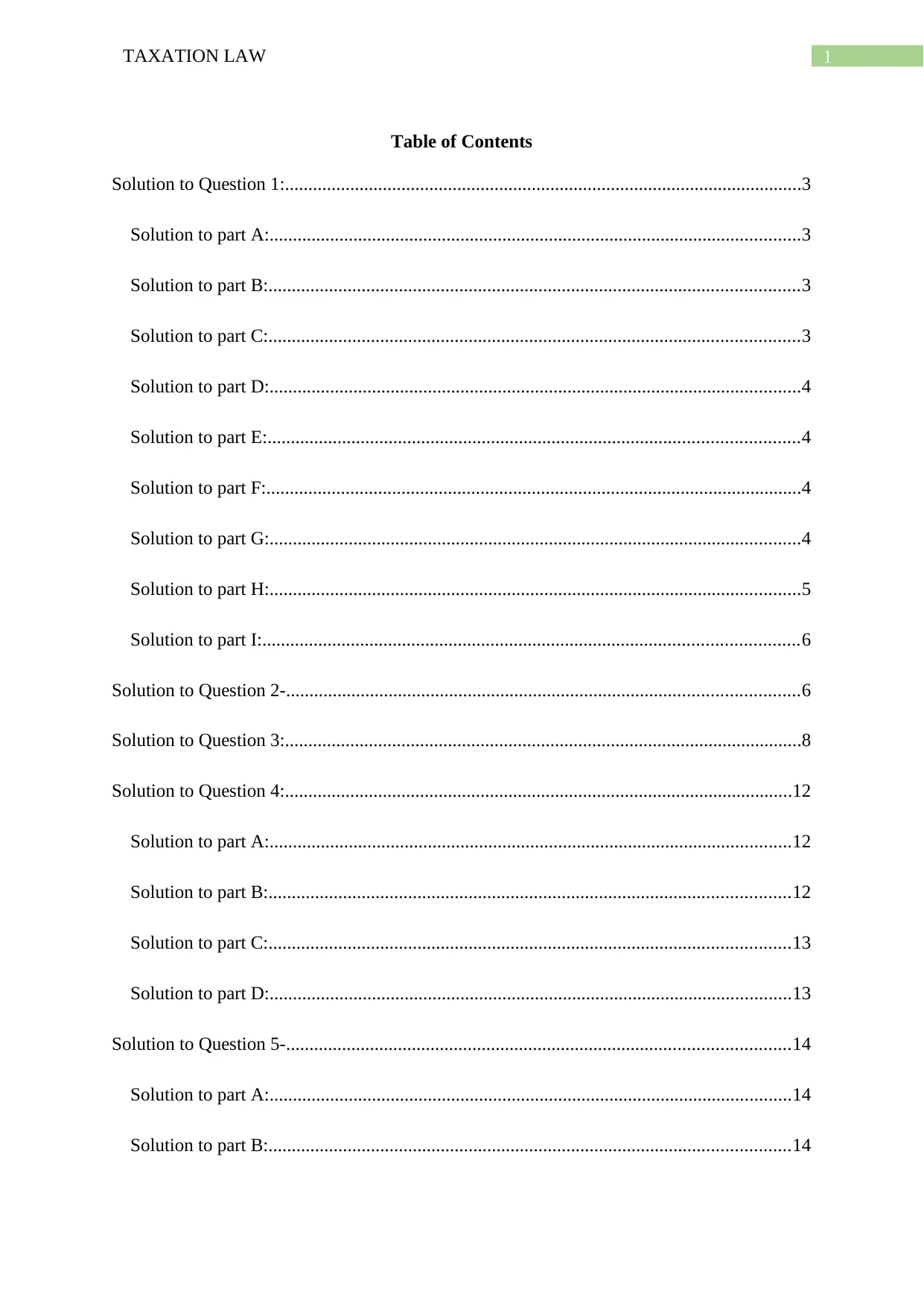
1TAXATION LAW
Table of Contents
Solution to Question 1:...............................................................................................................3
Solution to part A:..................................................................................................................3
Solution to part B:..................................................................................................................3
Solution to part C:..................................................................................................................3
Solution to part D:..................................................................................................................4
Solution to part E:..................................................................................................................4
Solution to part F:...................................................................................................................4
Solution to part G:..................................................................................................................4
Solution to part H:..................................................................................................................5
Solution to part I:...................................................................................................................6
Solution to Question 2-..............................................................................................................6
Solution to Question 3:...............................................................................................................8
Solution to Question 4:.............................................................................................................12
Solution to part A:................................................................................................................12
Solution to part B:................................................................................................................12
Solution to part C:................................................................................................................13
Solution to part D:................................................................................................................13
Solution to Question 5-............................................................................................................14
Solution to part A:................................................................................................................14
Solution to part B:................................................................................................................14
Table of Contents
Solution to Question 1:...............................................................................................................3
Solution to part A:..................................................................................................................3
Solution to part B:..................................................................................................................3
Solution to part C:..................................................................................................................3
Solution to part D:..................................................................................................................4
Solution to part E:..................................................................................................................4
Solution to part F:...................................................................................................................4
Solution to part G:..................................................................................................................4
Solution to part H:..................................................................................................................5
Solution to part I:...................................................................................................................6
Solution to Question 2-..............................................................................................................6
Solution to Question 3:...............................................................................................................8
Solution to Question 4:.............................................................................................................12
Solution to part A:................................................................................................................12
Solution to part B:................................................................................................................12
Solution to part C:................................................................................................................13
Solution to part D:................................................................................................................13
Solution to Question 5-............................................................................................................14
Solution to part A:................................................................................................................14
Solution to part B:................................................................................................................14
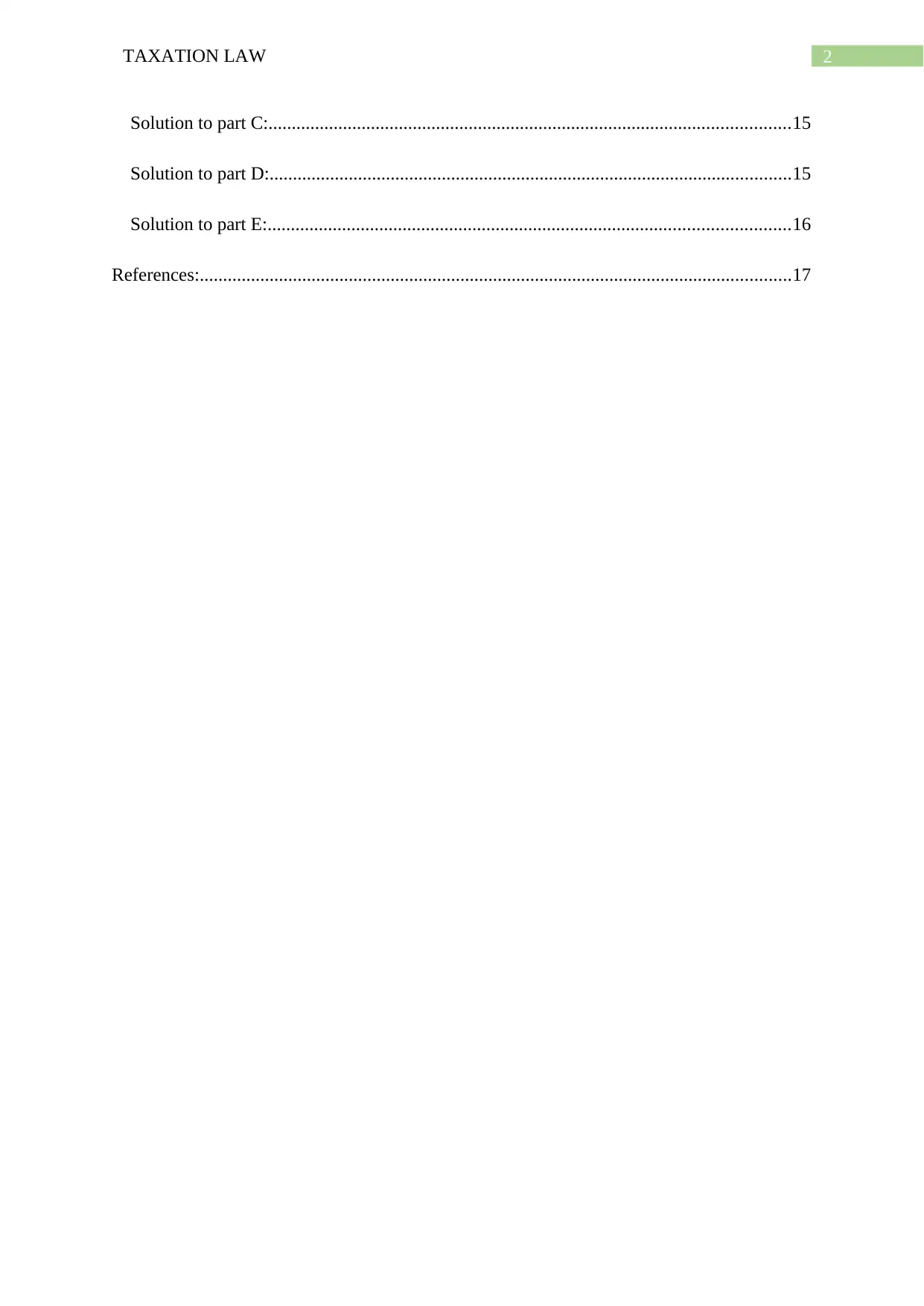
2TAXATION LAW
Solution to part C:................................................................................................................15
Solution to part D:................................................................................................................15
Solution to part E:................................................................................................................16
References:...............................................................................................................................17
Solution to part C:................................................................................................................15
Solution to part D:................................................................................................................15
Solution to part E:................................................................................................................16
References:...............................................................................................................................17
⊘ This is a preview!⊘
Do you want full access?
Subscribe today to unlock all pages.

Trusted by 1+ million students worldwide
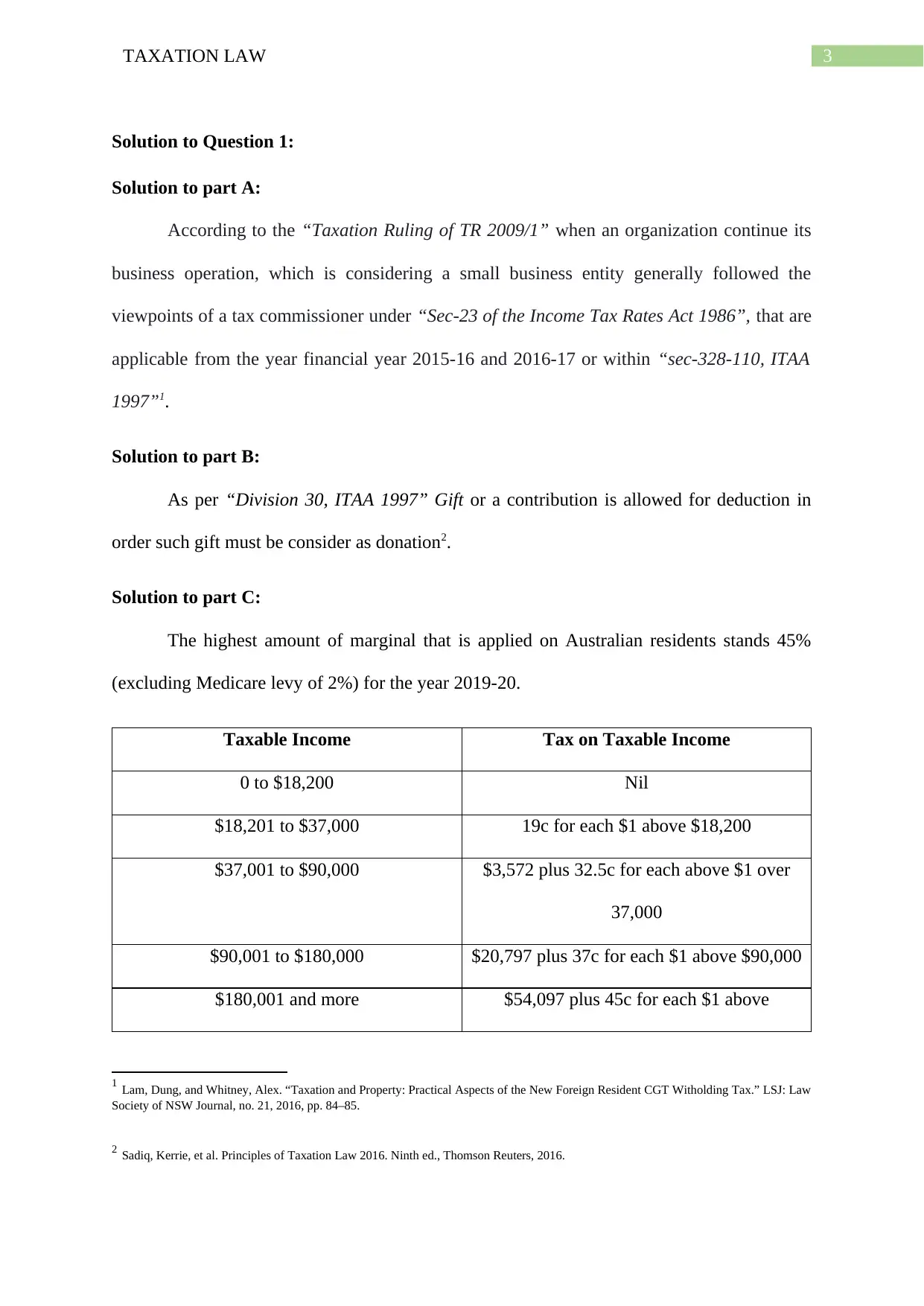
3TAXATION LAW
Solution to Question 1:
Solution to part A:
According to the “Taxation Ruling of TR 2009/1” when an organization continue its
business operation, which is considering a small business entity generally followed the
viewpoints of a tax commissioner under “Sec-23 of the Income Tax Rates Act 1986”, that are
applicable from the year financial year 2015-16 and 2016-17 or within “sec-328-110, ITAA
1997”1.
Solution to part B:
As per “Division 30, ITAA 1997” Gift or a contribution is allowed for deduction in
order such gift must be consider as donation2.
Solution to part C:
The highest amount of marginal that is applied on Australian residents stands 45%
(excluding Medicare levy of 2%) for the year 2019-20.
Taxable Income Tax on Taxable Income
0 to $18,200 Nil
$18,201 to $37,000 19c for each $1 above $18,200
$37,001 to $90,000 $3,572 plus 32.5c for each above $1 over
37,000
$90,001 to $180,000 $20,797 plus 37c for each $1 above $90,000
$180,001 and more $54,097 plus 45c for each $1 above
1 Lam, Dung, and Whitney, Alex. “Taxation and Property: Practical Aspects of the New Foreign Resident CGT Witholding Tax.” LSJ: Law
Society of NSW Journal, no. 21, 2016, pp. 84–85.
2 Sadiq, Kerrie, et al. Principles of Taxation Law 2016. Ninth ed., Thomson Reuters, 2016.
Solution to Question 1:
Solution to part A:
According to the “Taxation Ruling of TR 2009/1” when an organization continue its
business operation, which is considering a small business entity generally followed the
viewpoints of a tax commissioner under “Sec-23 of the Income Tax Rates Act 1986”, that are
applicable from the year financial year 2015-16 and 2016-17 or within “sec-328-110, ITAA
1997”1.
Solution to part B:
As per “Division 30, ITAA 1997” Gift or a contribution is allowed for deduction in
order such gift must be consider as donation2.
Solution to part C:
The highest amount of marginal that is applied on Australian residents stands 45%
(excluding Medicare levy of 2%) for the year 2019-20.
Taxable Income Tax on Taxable Income
0 to $18,200 Nil
$18,201 to $37,000 19c for each $1 above $18,200
$37,001 to $90,000 $3,572 plus 32.5c for each above $1 over
37,000
$90,001 to $180,000 $20,797 plus 37c for each $1 above $90,000
$180,001 and more $54,097 plus 45c for each $1 above
1 Lam, Dung, and Whitney, Alex. “Taxation and Property: Practical Aspects of the New Foreign Resident CGT Witholding Tax.” LSJ: Law
Society of NSW Journal, no. 21, 2016, pp. 84–85.
2 Sadiq, Kerrie, et al. Principles of Taxation Law 2016. Ninth ed., Thomson Reuters, 2016.
Paraphrase This Document
Need a fresh take? Get an instant paraphrase of this document with our AI Paraphraser
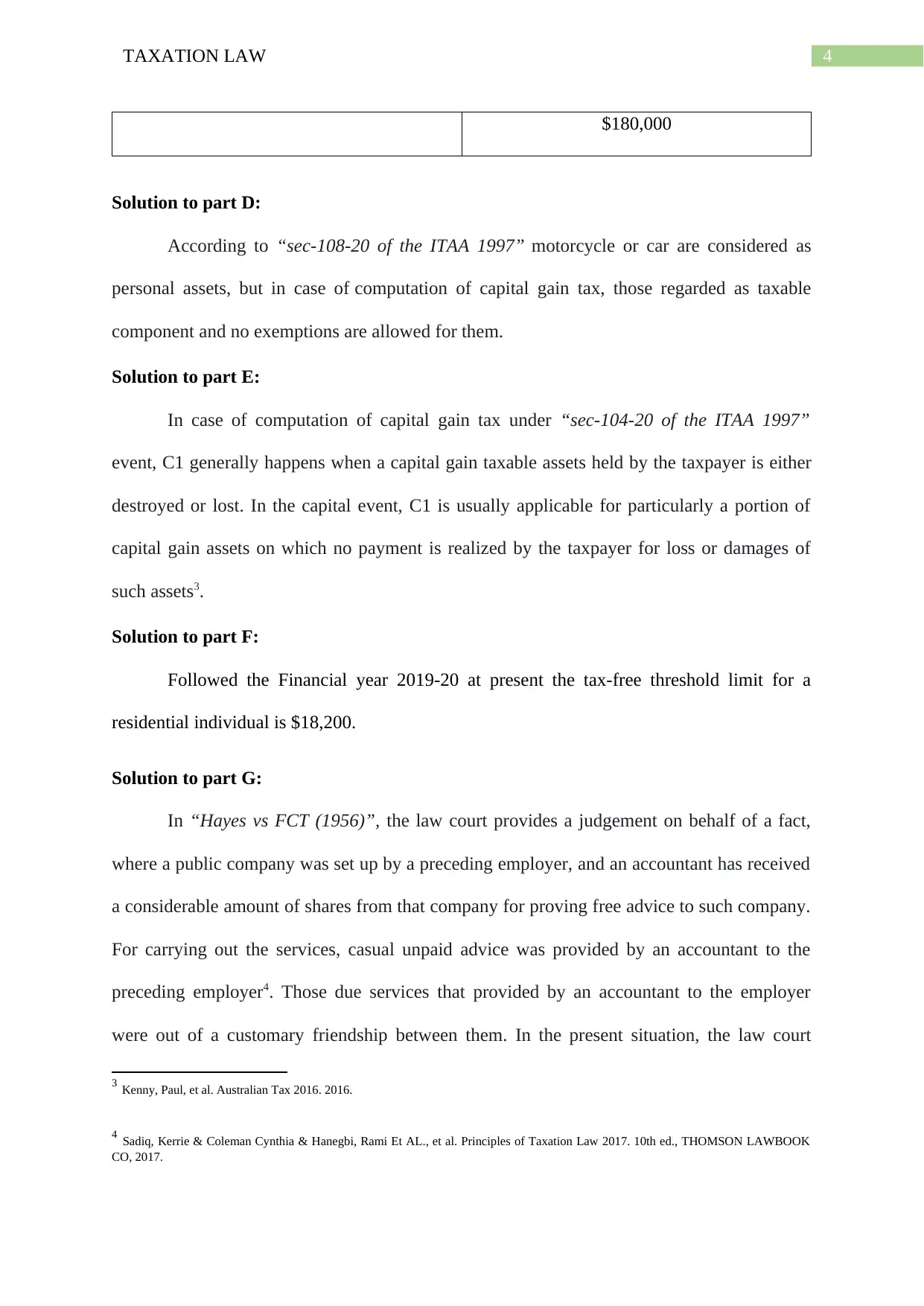
4TAXATION LAW
$180,000
Solution to part D:
According to “sec-108-20 of the ITAA 1997” motorcycle or car are considered as
personal assets, but in case of computation of capital gain tax, those regarded as taxable
component and no exemptions are allowed for them.
Solution to part E:
In case of computation of capital gain tax under “sec-104-20 of the ITAA 1997”
event, C1 generally happens when a capital gain taxable assets held by the taxpayer is either
destroyed or lost. In the capital event, C1 is usually applicable for particularly a portion of
capital gain assets on which no payment is realized by the taxpayer for loss or damages of
such assets3.
Solution to part F:
Followed the Financial year 2019-20 at present the tax-free threshold limit for a
residential individual is $18,200.
Solution to part G:
In “Hayes vs FCT (1956)”, the law court provides a judgement on behalf of a fact,
where a public company was set up by a preceding employer, and an accountant has received
a considerable amount of shares from that company for proving free advice to such company.
For carrying out the services, casual unpaid advice was provided by an accountant to the
preceding employer4. Those due services that provided by an accountant to the employer
were out of a customary friendship between them. In the present situation, the law court
3 Kenny, Paul, et al. Australian Tax 2016. 2016.
4 Sadiq, Kerrie & Coleman Cynthia & Hanegbi, Rami Et AL., et al. Principles of Taxation Law 2017. 10th ed., THOMSON LAWBOOK
CO, 2017.
$180,000
Solution to part D:
According to “sec-108-20 of the ITAA 1997” motorcycle or car are considered as
personal assets, but in case of computation of capital gain tax, those regarded as taxable
component and no exemptions are allowed for them.
Solution to part E:
In case of computation of capital gain tax under “sec-104-20 of the ITAA 1997”
event, C1 generally happens when a capital gain taxable assets held by the taxpayer is either
destroyed or lost. In the capital event, C1 is usually applicable for particularly a portion of
capital gain assets on which no payment is realized by the taxpayer for loss or damages of
such assets3.
Solution to part F:
Followed the Financial year 2019-20 at present the tax-free threshold limit for a
residential individual is $18,200.
Solution to part G:
In “Hayes vs FCT (1956)”, the law court provides a judgement on behalf of a fact,
where a public company was set up by a preceding employer, and an accountant has received
a considerable amount of shares from that company for proving free advice to such company.
For carrying out the services, casual unpaid advice was provided by an accountant to the
preceding employer4. Those due services that provided by an accountant to the employer
were out of a customary friendship between them. In the present situation, the law court
3 Kenny, Paul, et al. Australian Tax 2016. 2016.
4 Sadiq, Kerrie & Coleman Cynthia & Hanegbi, Rami Et AL., et al. Principles of Taxation Law 2017. 10th ed., THOMSON LAWBOOK
CO, 2017.
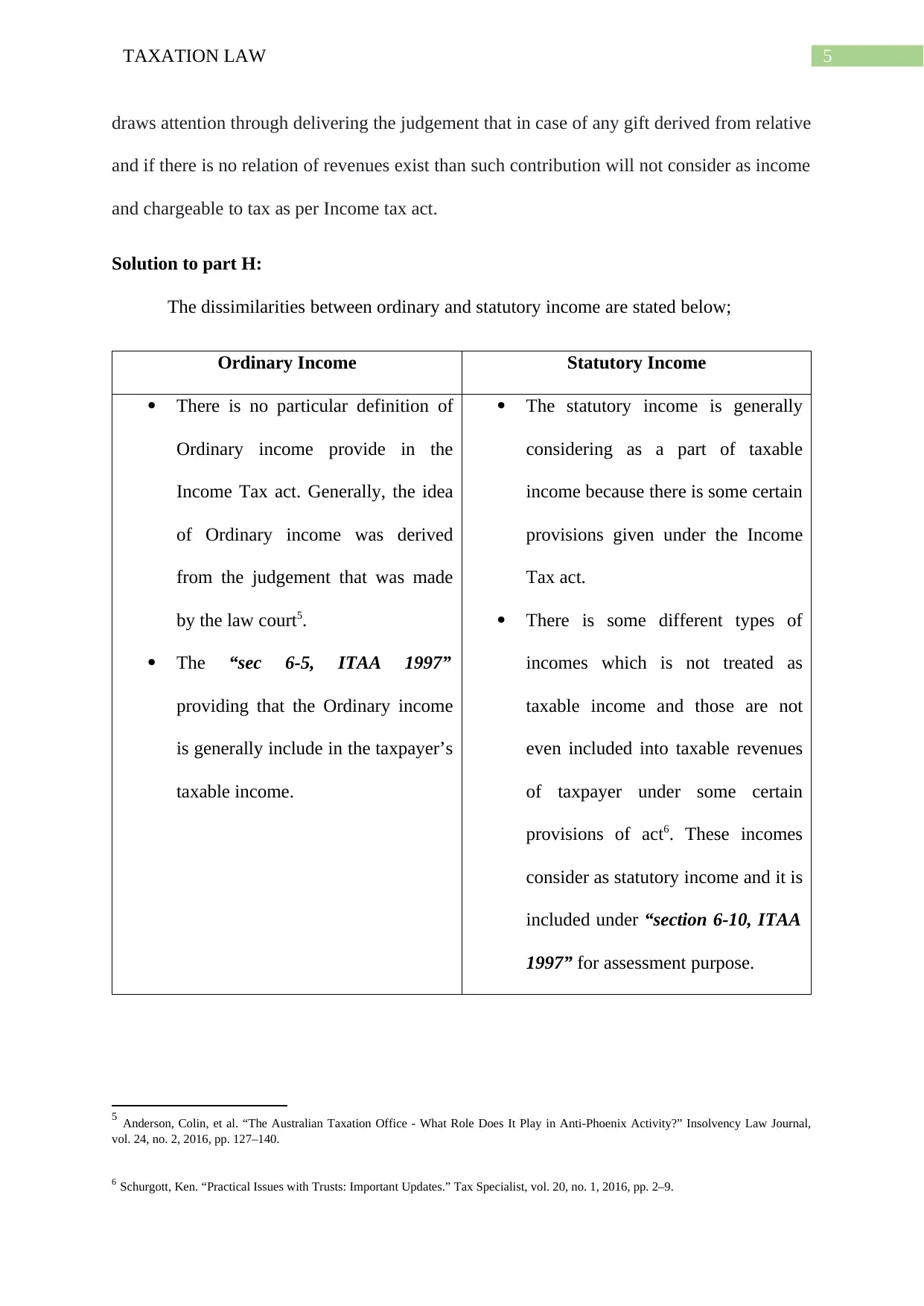
5TAXATION LAW
draws attention through delivering the judgement that in case of any gift derived from relative
and if there is no relation of revenues exist than such contribution will not consider as income
and chargeable to tax as per Income tax act.
Solution to part H:
The dissimilarities between ordinary and statutory income are stated below;
Ordinary Income Statutory Income
There is no particular definition of
Ordinary income provide in the
Income Tax act. Generally, the idea
of Ordinary income was derived
from the judgement that was made
by the law court5.
The “sec 6-5, ITAA 1997”
providing that the Ordinary income
is generally include in the taxpayer’s
taxable income.
The statutory income is generally
considering as a part of taxable
income because there is some certain
provisions given under the Income
Tax act.
There is some different types of
incomes which is not treated as
taxable income and those are not
even included into taxable revenues
of taxpayer under some certain
provisions of act6. These incomes
consider as statutory income and it is
included under “section 6-10, ITAA
1997” for assessment purpose.
5 Anderson, Colin, et al. “The Australian Taxation Office - What Role Does It Play in Anti-Phoenix Activity?” Insolvency Law Journal,
vol. 24, no. 2, 2016, pp. 127–140.
6 Schurgott, Ken. “Practical Issues with Trusts: Important Updates.” Tax Specialist, vol. 20, no. 1, 2016, pp. 2–9.
draws attention through delivering the judgement that in case of any gift derived from relative
and if there is no relation of revenues exist than such contribution will not consider as income
and chargeable to tax as per Income tax act.
Solution to part H:
The dissimilarities between ordinary and statutory income are stated below;
Ordinary Income Statutory Income
There is no particular definition of
Ordinary income provide in the
Income Tax act. Generally, the idea
of Ordinary income was derived
from the judgement that was made
by the law court5.
The “sec 6-5, ITAA 1997”
providing that the Ordinary income
is generally include in the taxpayer’s
taxable income.
The statutory income is generally
considering as a part of taxable
income because there is some certain
provisions given under the Income
Tax act.
There is some different types of
incomes which is not treated as
taxable income and those are not
even included into taxable revenues
of taxpayer under some certain
provisions of act6. These incomes
consider as statutory income and it is
included under “section 6-10, ITAA
1997” for assessment purpose.
5 Anderson, Colin, et al. “The Australian Taxation Office - What Role Does It Play in Anti-Phoenix Activity?” Insolvency Law Journal,
vol. 24, no. 2, 2016, pp. 127–140.
6 Schurgott, Ken. “Practical Issues with Trusts: Important Updates.” Tax Specialist, vol. 20, no. 1, 2016, pp. 2–9.
⊘ This is a preview!⊘
Do you want full access?
Subscribe today to unlock all pages.

Trusted by 1+ million students worldwide
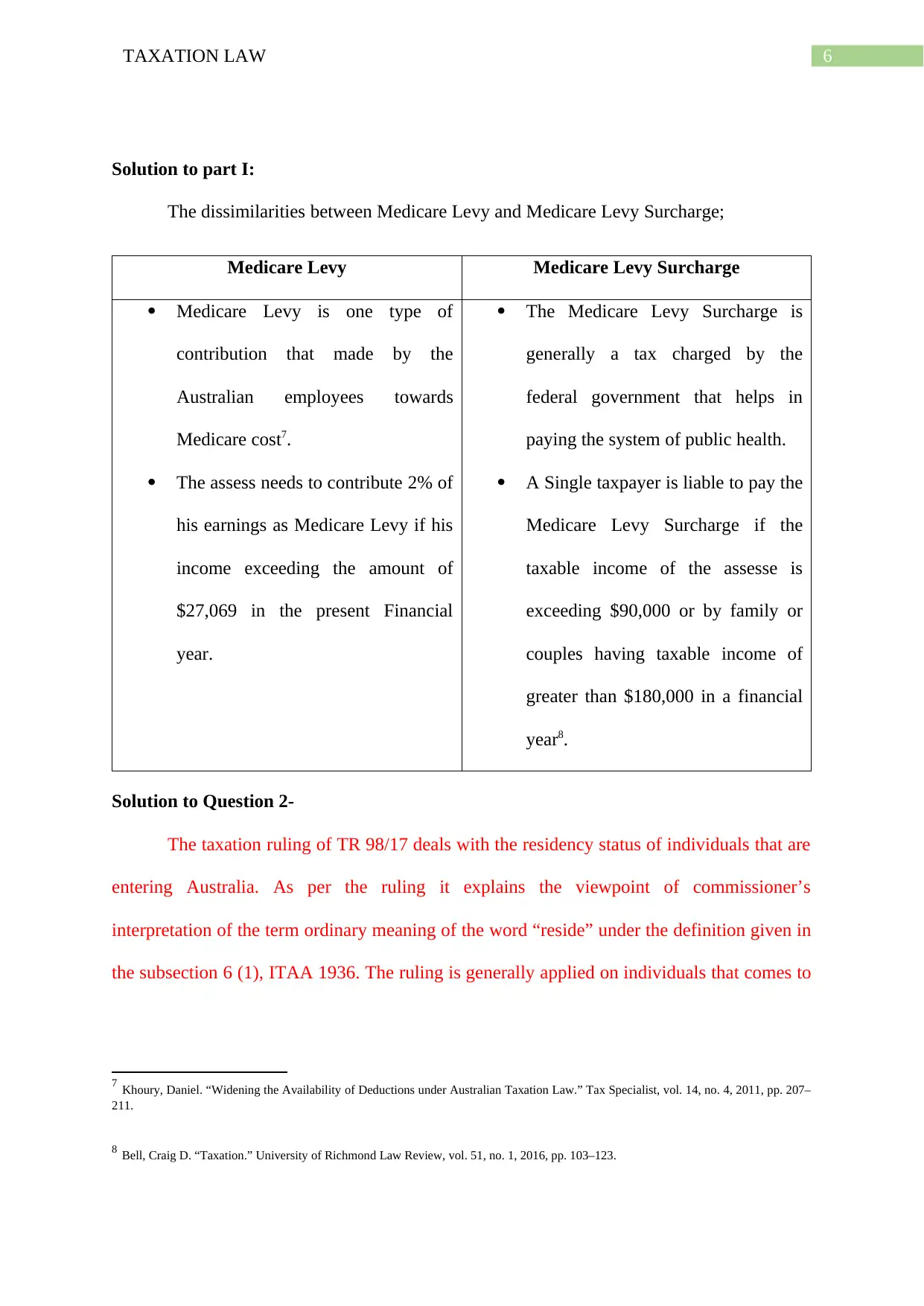
6TAXATION LAW
Solution to part I:
The dissimilarities between Medicare Levy and Medicare Levy Surcharge;
Medicare Levy Medicare Levy Surcharge
Medicare Levy is one type of
contribution that made by the
Australian employees towards
Medicare cost7.
The assess needs to contribute 2% of
his earnings as Medicare Levy if his
income exceeding the amount of
$27,069 in the present Financial
year.
The Medicare Levy Surcharge is
generally a tax charged by the
federal government that helps in
paying the system of public health.
A Single taxpayer is liable to pay the
Medicare Levy Surcharge if the
taxable income of the assesse is
exceeding $90,000 or by family or
couples having taxable income of
greater than $180,000 in a financial
year8.
Solution to Question 2-
The taxation ruling of TR 98/17 deals with the residency status of individuals that are
entering Australia. As per the ruling it explains the viewpoint of commissioner’s
interpretation of the term ordinary meaning of the word “reside” under the definition given in
the subsection 6 (1), ITAA 1936. The ruling is generally applied on individuals that comes to
7 Khoury, Daniel. “Widening the Availability of Deductions under Australian Taxation Law.” Tax Specialist, vol. 14, no. 4, 2011, pp. 207–
211.
8 Bell, Craig D. “Taxation.” University of Richmond Law Review, vol. 51, no. 1, 2016, pp. 103–123.
Solution to part I:
The dissimilarities between Medicare Levy and Medicare Levy Surcharge;
Medicare Levy Medicare Levy Surcharge
Medicare Levy is one type of
contribution that made by the
Australian employees towards
Medicare cost7.
The assess needs to contribute 2% of
his earnings as Medicare Levy if his
income exceeding the amount of
$27,069 in the present Financial
year.
The Medicare Levy Surcharge is
generally a tax charged by the
federal government that helps in
paying the system of public health.
A Single taxpayer is liable to pay the
Medicare Levy Surcharge if the
taxable income of the assesse is
exceeding $90,000 or by family or
couples having taxable income of
greater than $180,000 in a financial
year8.
Solution to Question 2-
The taxation ruling of TR 98/17 deals with the residency status of individuals that are
entering Australia. As per the ruling it explains the viewpoint of commissioner’s
interpretation of the term ordinary meaning of the word “reside” under the definition given in
the subsection 6 (1), ITAA 1936. The ruling is generally applied on individuals that comes to
7 Khoury, Daniel. “Widening the Availability of Deductions under Australian Taxation Law.” Tax Specialist, vol. 14, no. 4, 2011, pp. 207–
211.
8 Bell, Craig D. “Taxation.” University of Richmond Law Review, vol. 51, no. 1, 2016, pp. 103–123.
Paraphrase This Document
Need a fresh take? Get an instant paraphrase of this document with our AI Paraphraser
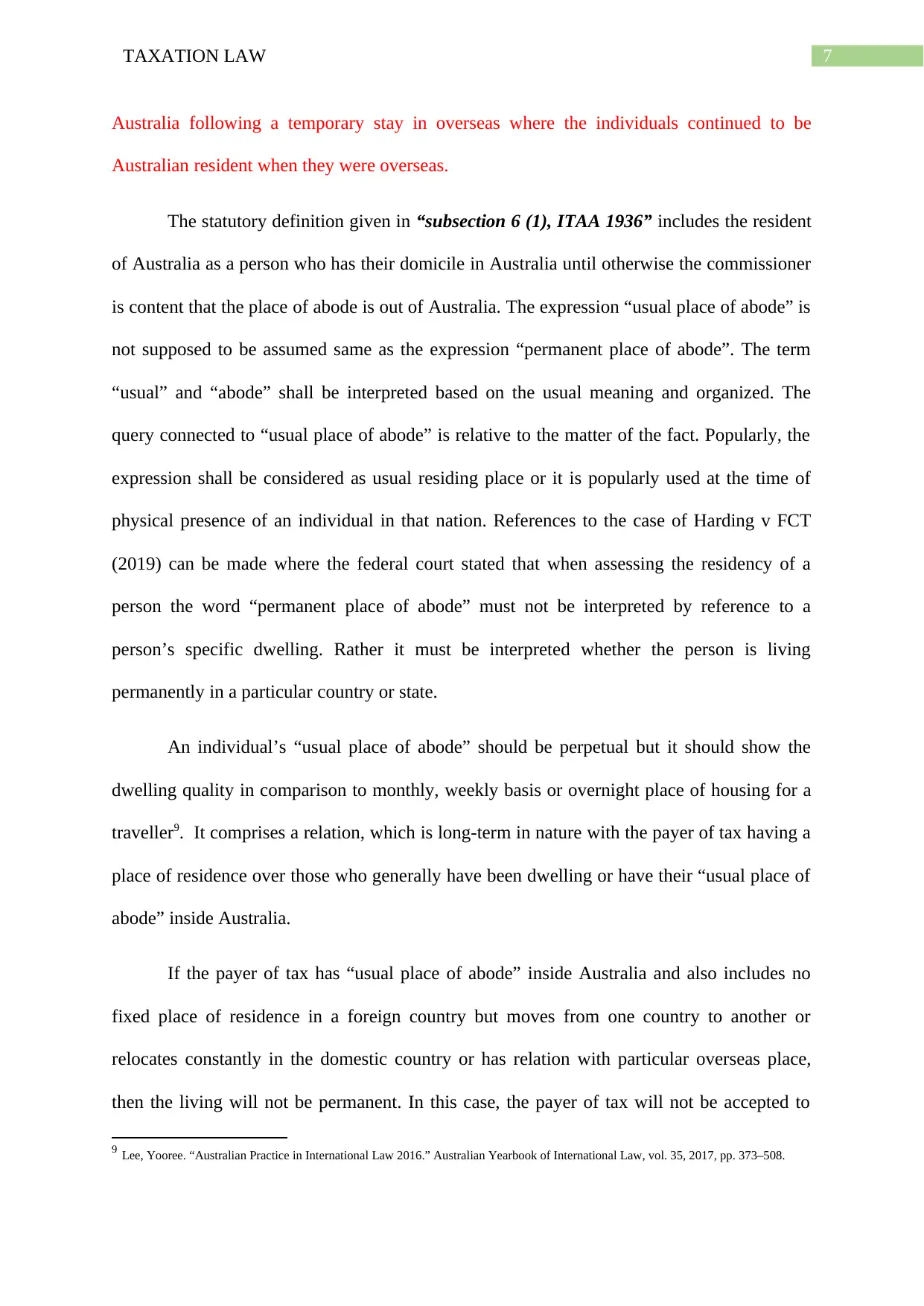
7TAXATION LAW
Australia following a temporary stay in overseas where the individuals continued to be
Australian resident when they were overseas.
The statutory definition given in “subsection 6 (1), ITAA 1936” includes the resident
of Australia as a person who has their domicile in Australia until otherwise the commissioner
is content that the place of abode is out of Australia. The expression “usual place of abode” is
not supposed to be assumed same as the expression “permanent place of abode”. The term
“usual” and “abode” shall be interpreted based on the usual meaning and organized. The
query connected to “usual place of abode” is relative to the matter of the fact. Popularly, the
expression shall be considered as usual residing place or it is popularly used at the time of
physical presence of an individual in that nation. References to the case of Harding v FCT
(2019) can be made where the federal court stated that when assessing the residency of a
person the word “permanent place of abode” must not be interpreted by reference to a
person’s specific dwelling. Rather it must be interpreted whether the person is living
permanently in a particular country or state.
An individual’s “usual place of abode” should be perpetual but it should show the
dwelling quality in comparison to monthly, weekly basis or overnight place of housing for a
traveller9. It comprises a relation, which is long-term in nature with the payer of tax having a
place of residence over those who generally have been dwelling or have their “usual place of
abode” inside Australia.
If the payer of tax has “usual place of abode” inside Australia and also includes no
fixed place of residence in a foreign country but moves from one country to another or
relocates constantly in the domestic country or has relation with particular overseas place,
then the living will not be permanent. In this case, the payer of tax will not be accepted to
9 Lee, Yooree. “Australian Practice in International Law 2016.” Australian Yearbook of International Law, vol. 35, 2017, pp. 373–508.
Australia following a temporary stay in overseas where the individuals continued to be
Australian resident when they were overseas.
The statutory definition given in “subsection 6 (1), ITAA 1936” includes the resident
of Australia as a person who has their domicile in Australia until otherwise the commissioner
is content that the place of abode is out of Australia. The expression “usual place of abode” is
not supposed to be assumed same as the expression “permanent place of abode”. The term
“usual” and “abode” shall be interpreted based on the usual meaning and organized. The
query connected to “usual place of abode” is relative to the matter of the fact. Popularly, the
expression shall be considered as usual residing place or it is popularly used at the time of
physical presence of an individual in that nation. References to the case of Harding v FCT
(2019) can be made where the federal court stated that when assessing the residency of a
person the word “permanent place of abode” must not be interpreted by reference to a
person’s specific dwelling. Rather it must be interpreted whether the person is living
permanently in a particular country or state.
An individual’s “usual place of abode” should be perpetual but it should show the
dwelling quality in comparison to monthly, weekly basis or overnight place of housing for a
traveller9. It comprises a relation, which is long-term in nature with the payer of tax having a
place of residence over those who generally have been dwelling or have their “usual place of
abode” inside Australia.
If the payer of tax has “usual place of abode” inside Australia and also includes no
fixed place of residence in a foreign country but moves from one country to another or
relocates constantly in the domestic country or has relation with particular overseas place,
then the living will not be permanent. In this case, the payer of tax will not be accepted to
9 Lee, Yooree. “Australian Practice in International Law 2016.” Australian Yearbook of International Law, vol. 35, 2017, pp. 373–508.
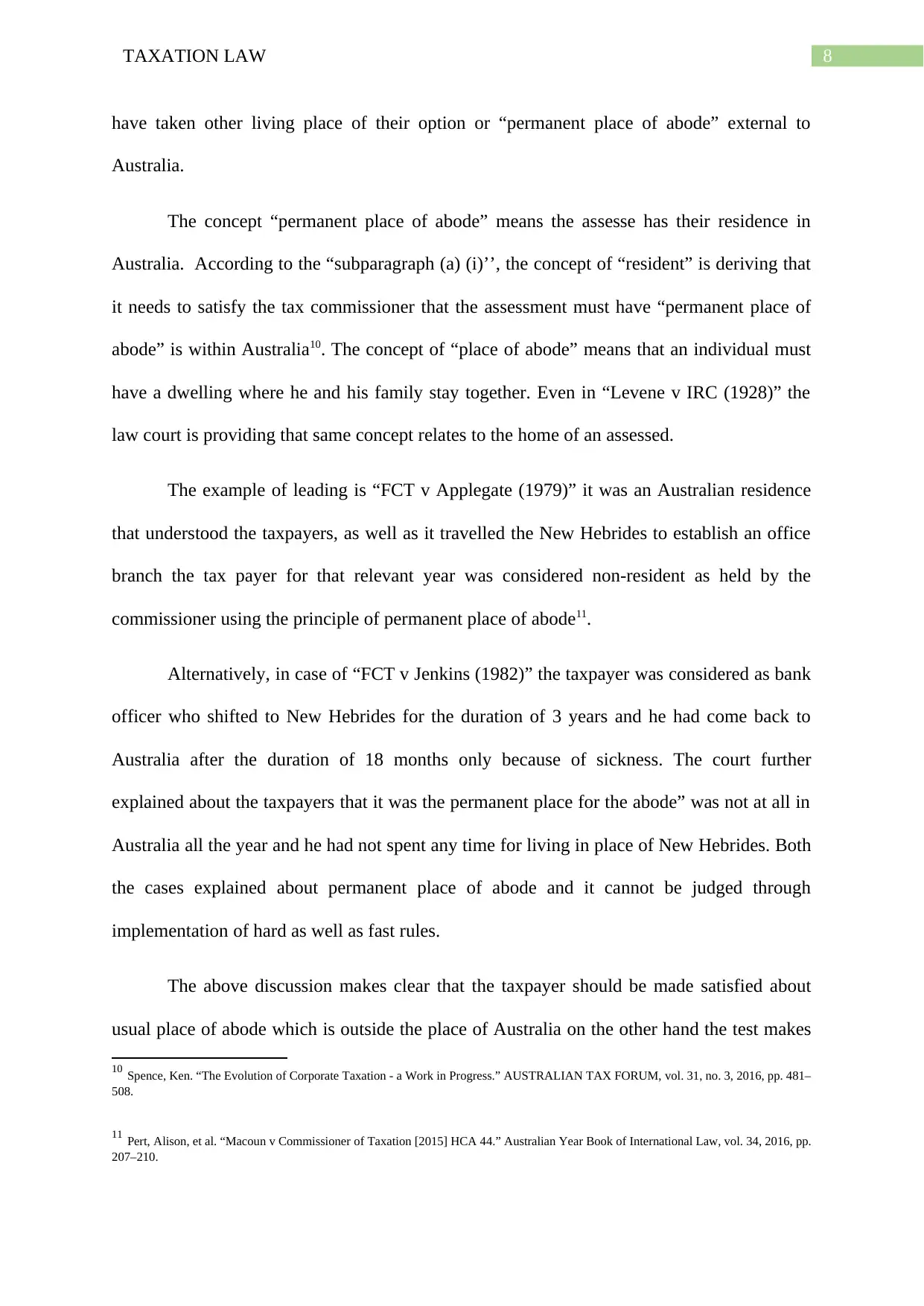
8TAXATION LAW
have taken other living place of their option or “permanent place of abode” external to
Australia.
The concept “permanent place of abode” means the assesse has their residence in
Australia. According to the “subparagraph (a) (i)’’, the concept of “resident” is deriving that
it needs to satisfy the tax commissioner that the assessment must have “permanent place of
abode” is within Australia10. The concept of “place of abode” means that an individual must
have a dwelling where he and his family stay together. Even in “Levene v IRC (1928)” the
law court is providing that same concept relates to the home of an assessed.
The example of leading is “FCT v Applegate (1979)” it was an Australian residence
that understood the taxpayers, as well as it travelled the New Hebrides to establish an office
branch the tax payer for that relevant year was considered non-resident as held by the
commissioner using the principle of permanent place of abode11.
Alternatively, in case of “FCT v Jenkins (1982)” the taxpayer was considered as bank
officer who shifted to New Hebrides for the duration of 3 years and he had come back to
Australia after the duration of 18 months only because of sickness. The court further
explained about the taxpayers that it was the permanent place for the abode” was not at all in
Australia all the year and he had not spent any time for living in place of New Hebrides. Both
the cases explained about permanent place of abode and it cannot be judged through
implementation of hard as well as fast rules.
The above discussion makes clear that the taxpayer should be made satisfied about
usual place of abode which is outside the place of Australia on the other hand the test makes
10 Spence, Ken. “The Evolution of Corporate Taxation - a Work in Progress.” AUSTRALIAN TAX FORUM, vol. 31, no. 3, 2016, pp. 481–
508.
11 Pert, Alison, et al. “Macoun v Commissioner of Taxation [2015] HCA 44.” Australian Year Book of International Law, vol. 34, 2016, pp.
207–210.
have taken other living place of their option or “permanent place of abode” external to
Australia.
The concept “permanent place of abode” means the assesse has their residence in
Australia. According to the “subparagraph (a) (i)’’, the concept of “resident” is deriving that
it needs to satisfy the tax commissioner that the assessment must have “permanent place of
abode” is within Australia10. The concept of “place of abode” means that an individual must
have a dwelling where he and his family stay together. Even in “Levene v IRC (1928)” the
law court is providing that same concept relates to the home of an assessed.
The example of leading is “FCT v Applegate (1979)” it was an Australian residence
that understood the taxpayers, as well as it travelled the New Hebrides to establish an office
branch the tax payer for that relevant year was considered non-resident as held by the
commissioner using the principle of permanent place of abode11.
Alternatively, in case of “FCT v Jenkins (1982)” the taxpayer was considered as bank
officer who shifted to New Hebrides for the duration of 3 years and he had come back to
Australia after the duration of 18 months only because of sickness. The court further
explained about the taxpayers that it was the permanent place for the abode” was not at all in
Australia all the year and he had not spent any time for living in place of New Hebrides. Both
the cases explained about permanent place of abode and it cannot be judged through
implementation of hard as well as fast rules.
The above discussion makes clear that the taxpayer should be made satisfied about
usual place of abode which is outside the place of Australia on the other hand the test makes
10 Spence, Ken. “The Evolution of Corporate Taxation - a Work in Progress.” AUSTRALIAN TAX FORUM, vol. 31, no. 3, 2016, pp. 481–
508.
11 Pert, Alison, et al. “Macoun v Commissioner of Taxation [2015] HCA 44.” Australian Year Book of International Law, vol. 34, 2016, pp.
207–210.
⊘ This is a preview!⊘
Do you want full access?
Subscribe today to unlock all pages.

Trusted by 1+ million students worldwide
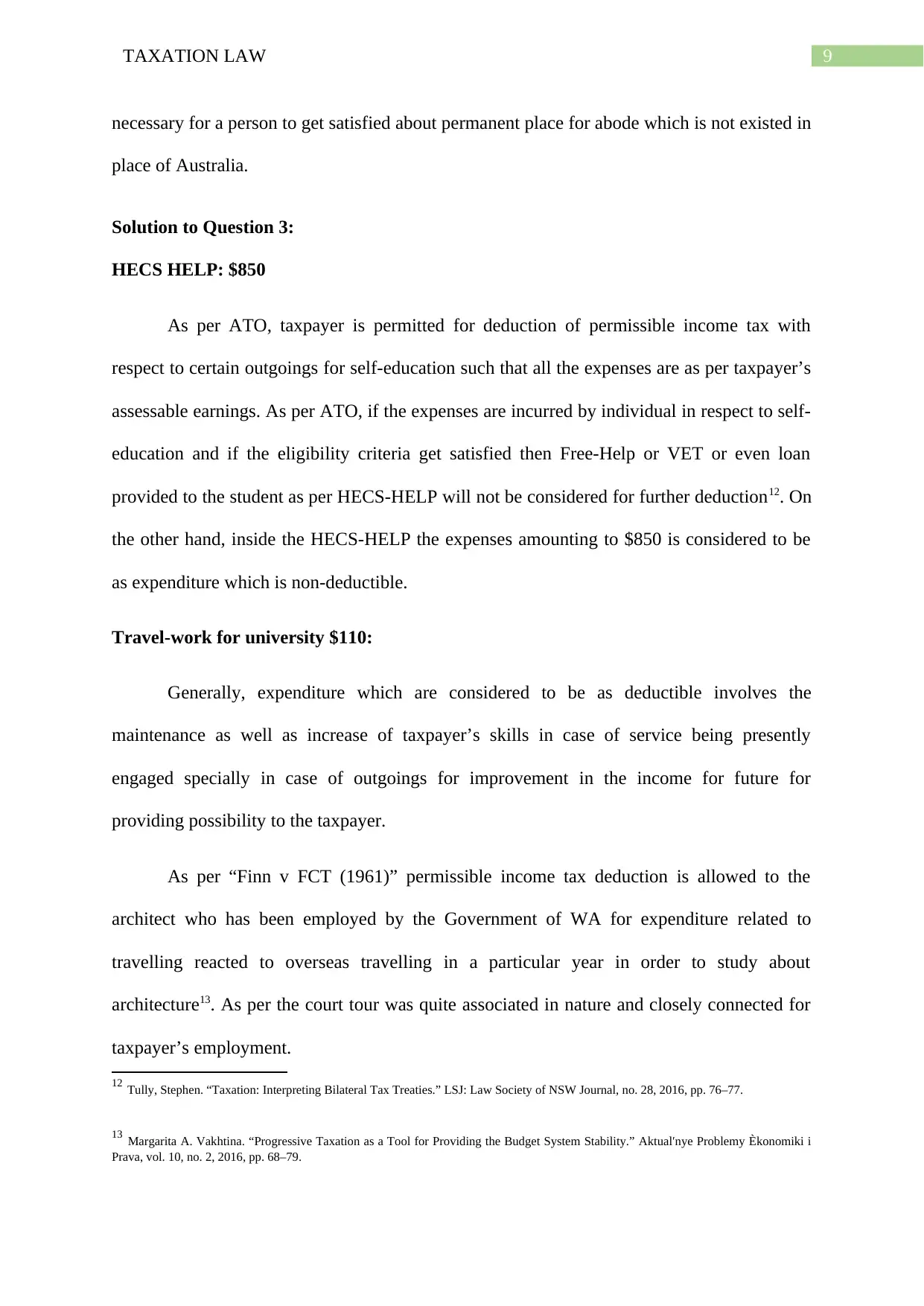
9TAXATION LAW
necessary for a person to get satisfied about permanent place for abode which is not existed in
place of Australia.
Solution to Question 3:
HECS HELP: $850
As per ATO, taxpayer is permitted for deduction of permissible income tax with
respect to certain outgoings for self-education such that all the expenses are as per taxpayer’s
assessable earnings. As per ATO, if the expenses are incurred by individual in respect to self-
education and if the eligibility criteria get satisfied then Free-Help or VET or even loan
provided to the student as per HECS-HELP will not be considered for further deduction12. On
the other hand, inside the HECS-HELP the expenses amounting to $850 is considered to be
as expenditure which is non-deductible.
Travel-work for university $110:
Generally, expenditure which are considered to be as deductible involves the
maintenance as well as increase of taxpayer’s skills in case of service being presently
engaged specially in case of outgoings for improvement in the income for future for
providing possibility to the taxpayer.
As per “Finn v FCT (1961)” permissible income tax deduction is allowed to the
architect who has been employed by the Government of WA for expenditure related to
travelling reacted to overseas travelling in a particular year in order to study about
architecture13. As per the court tour was quite associated in nature and closely connected for
taxpayer’s employment.
12 Tully, Stephen. “Taxation: Interpreting Bilateral Tax Treaties.” LSJ: Law Society of NSW Journal, no. 28, 2016, pp. 76–77.
13 Margarita A. Vakhtina. “Progressive Taxation as a Tool for Providing the Budget System Stability.” Aktualʹnye Problemy Èkonomiki i
Prava, vol. 10, no. 2, 2016, pp. 68–79.
necessary for a person to get satisfied about permanent place for abode which is not existed in
place of Australia.
Solution to Question 3:
HECS HELP: $850
As per ATO, taxpayer is permitted for deduction of permissible income tax with
respect to certain outgoings for self-education such that all the expenses are as per taxpayer’s
assessable earnings. As per ATO, if the expenses are incurred by individual in respect to self-
education and if the eligibility criteria get satisfied then Free-Help or VET or even loan
provided to the student as per HECS-HELP will not be considered for further deduction12. On
the other hand, inside the HECS-HELP the expenses amounting to $850 is considered to be
as expenditure which is non-deductible.
Travel-work for university $110:
Generally, expenditure which are considered to be as deductible involves the
maintenance as well as increase of taxpayer’s skills in case of service being presently
engaged specially in case of outgoings for improvement in the income for future for
providing possibility to the taxpayer.
As per “Finn v FCT (1961)” permissible income tax deduction is allowed to the
architect who has been employed by the Government of WA for expenditure related to
travelling reacted to overseas travelling in a particular year in order to study about
architecture13. As per the court tour was quite associated in nature and closely connected for
taxpayer’s employment.
12 Tully, Stephen. “Taxation: Interpreting Bilateral Tax Treaties.” LSJ: Law Society of NSW Journal, no. 28, 2016, pp. 76–77.
13 Margarita A. Vakhtina. “Progressive Taxation as a Tool for Providing the Budget System Stability.” Aktualʹnye Problemy Èkonomiki i
Prava, vol. 10, no. 2, 2016, pp. 68–79.
Paraphrase This Document
Need a fresh take? Get an instant paraphrase of this document with our AI Paraphraser
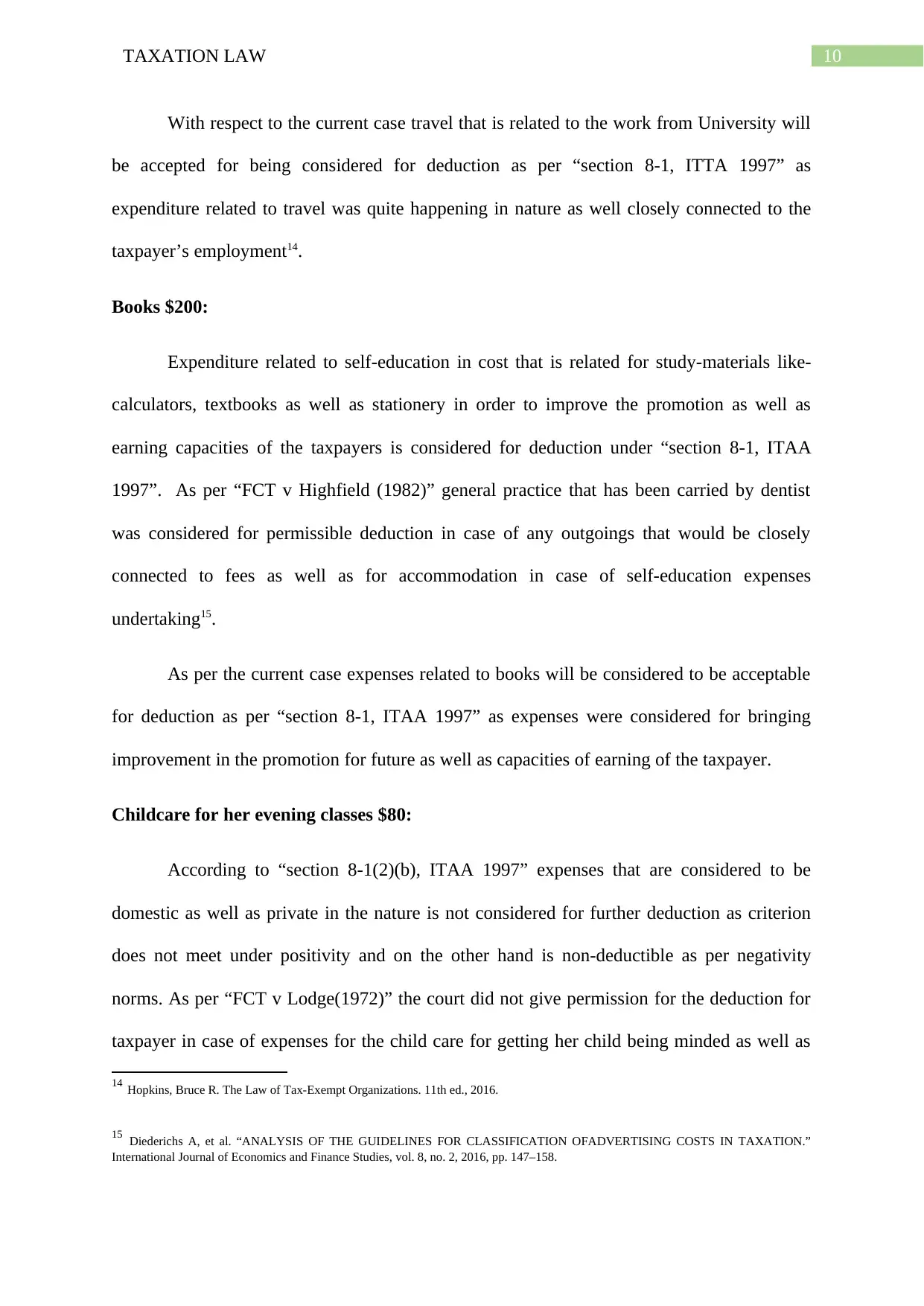
10TAXATION LAW
With respect to the current case travel that is related to the work from University will
be accepted for being considered for deduction as per “section 8-1, ITTA 1997” as
expenditure related to travel was quite happening in nature as well closely connected to the
taxpayer’s employment14.
Books $200:
Expenditure related to self-education in cost that is related for study-materials like-
calculators, textbooks as well as stationery in order to improve the promotion as well as
earning capacities of the taxpayers is considered for deduction under “section 8-1, ITAA
1997”. As per “FCT v Highfield (1982)” general practice that has been carried by dentist
was considered for permissible deduction in case of any outgoings that would be closely
connected to fees as well as for accommodation in case of self-education expenses
undertaking15.
As per the current case expenses related to books will be considered to be acceptable
for deduction as per “section 8-1, ITAA 1997” as expenses were considered for bringing
improvement in the promotion for future as well as capacities of earning of the taxpayer.
Childcare for her evening classes $80:
According to “section 8-1(2)(b), ITAA 1997” expenses that are considered to be
domestic as well as private in the nature is not considered for further deduction as criterion
does not meet under positivity and on the other hand is non-deductible as per negativity
norms. As per “FCT v Lodge(1972)” the court did not give permission for the deduction for
taxpayer in case of expenses for the child care for getting her child being minded as well as
14 Hopkins, Bruce R. The Law of Tax-Exempt Organizations. 11th ed., 2016.
15 Diederichs A, et al. “ANALYSIS OF THE GUIDELINES FOR CLASSIFICATION OFADVERTISING COSTS IN TAXATION.”
International Journal of Economics and Finance Studies, vol. 8, no. 2, 2016, pp. 147–158.
With respect to the current case travel that is related to the work from University will
be accepted for being considered for deduction as per “section 8-1, ITTA 1997” as
expenditure related to travel was quite happening in nature as well closely connected to the
taxpayer’s employment14.
Books $200:
Expenditure related to self-education in cost that is related for study-materials like-
calculators, textbooks as well as stationery in order to improve the promotion as well as
earning capacities of the taxpayers is considered for deduction under “section 8-1, ITAA
1997”. As per “FCT v Highfield (1982)” general practice that has been carried by dentist
was considered for permissible deduction in case of any outgoings that would be closely
connected to fees as well as for accommodation in case of self-education expenses
undertaking15.
As per the current case expenses related to books will be considered to be acceptable
for deduction as per “section 8-1, ITAA 1997” as expenses were considered for bringing
improvement in the promotion for future as well as capacities of earning of the taxpayer.
Childcare for her evening classes $80:
According to “section 8-1(2)(b), ITAA 1997” expenses that are considered to be
domestic as well as private in the nature is not considered for further deduction as criterion
does not meet under positivity and on the other hand is non-deductible as per negativity
norms. As per “FCT v Lodge(1972)” the court did not give permission for the deduction for
taxpayer in case of expenses for the child care for getting her child being minded as well as
14 Hopkins, Bruce R. The Law of Tax-Exempt Organizations. 11th ed., 2016.
15 Diederichs A, et al. “ANALYSIS OF THE GUIDELINES FOR CLASSIFICATION OFADVERTISING COSTS IN TAXATION.”
International Journal of Economics and Finance Studies, vol. 8, no. 2, 2016, pp. 147–158.
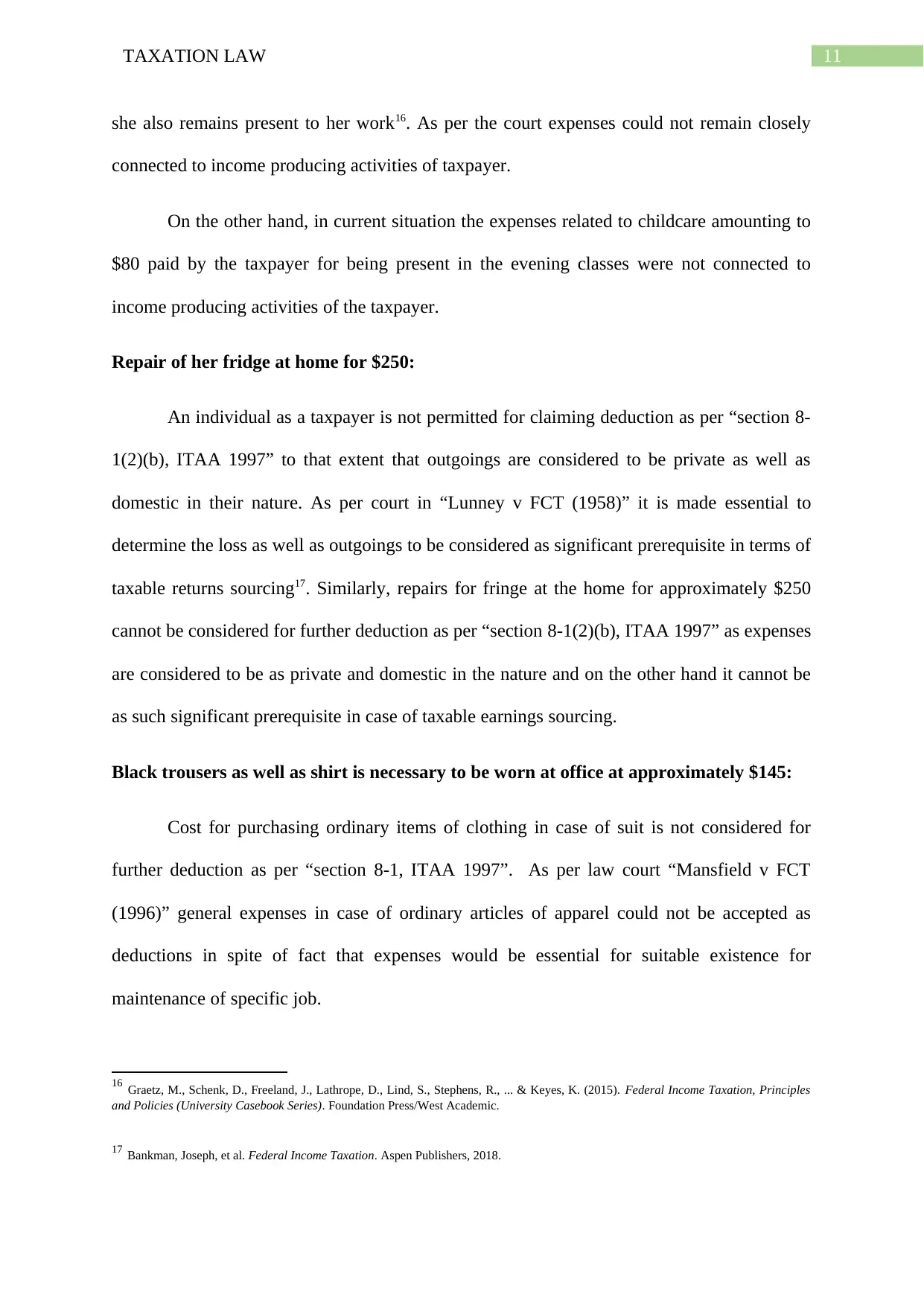
11TAXATION LAW
she also remains present to her work16. As per the court expenses could not remain closely
connected to income producing activities of taxpayer.
On the other hand, in current situation the expenses related to childcare amounting to
$80 paid by the taxpayer for being present in the evening classes were not connected to
income producing activities of the taxpayer.
Repair of her fridge at home for $250:
An individual as a taxpayer is not permitted for claiming deduction as per “section 8-
1(2)(b), ITAA 1997” to that extent that outgoings are considered to be private as well as
domestic in their nature. As per court in “Lunney v FCT (1958)” it is made essential to
determine the loss as well as outgoings to be considered as significant prerequisite in terms of
taxable returns sourcing17. Similarly, repairs for fringe at the home for approximately $250
cannot be considered for further deduction as per “section 8-1(2)(b), ITAA 1997” as expenses
are considered to be as private and domestic in the nature and on the other hand it cannot be
as such significant prerequisite in case of taxable earnings sourcing.
Black trousers as well as shirt is necessary to be worn at office at approximately $145:
Cost for purchasing ordinary items of clothing in case of suit is not considered for
further deduction as per “section 8-1, ITAA 1997”. As per law court “Mansfield v FCT
(1996)” general expenses in case of ordinary articles of apparel could not be accepted as
deductions in spite of fact that expenses would be essential for suitable existence for
maintenance of specific job.
16 Graetz, M., Schenk, D., Freeland, J., Lathrope, D., Lind, S., Stephens, R., ... & Keyes, K. (2015). Federal Income Taxation, Principles
and Policies (University Casebook Series). Foundation Press/West Academic.
17 Bankman, Joseph, et al. Federal Income Taxation. Aspen Publishers, 2018.
she also remains present to her work16. As per the court expenses could not remain closely
connected to income producing activities of taxpayer.
On the other hand, in current situation the expenses related to childcare amounting to
$80 paid by the taxpayer for being present in the evening classes were not connected to
income producing activities of the taxpayer.
Repair of her fridge at home for $250:
An individual as a taxpayer is not permitted for claiming deduction as per “section 8-
1(2)(b), ITAA 1997” to that extent that outgoings are considered to be private as well as
domestic in their nature. As per court in “Lunney v FCT (1958)” it is made essential to
determine the loss as well as outgoings to be considered as significant prerequisite in terms of
taxable returns sourcing17. Similarly, repairs for fringe at the home for approximately $250
cannot be considered for further deduction as per “section 8-1(2)(b), ITAA 1997” as expenses
are considered to be as private and domestic in the nature and on the other hand it cannot be
as such significant prerequisite in case of taxable earnings sourcing.
Black trousers as well as shirt is necessary to be worn at office at approximately $145:
Cost for purchasing ordinary items of clothing in case of suit is not considered for
further deduction as per “section 8-1, ITAA 1997”. As per law court “Mansfield v FCT
(1996)” general expenses in case of ordinary articles of apparel could not be accepted as
deductions in spite of fact that expenses would be essential for suitable existence for
maintenance of specific job.
16 Graetz, M., Schenk, D., Freeland, J., Lathrope, D., Lind, S., Stephens, R., ... & Keyes, K. (2015). Federal Income Taxation, Principles
and Policies (University Casebook Series). Foundation Press/West Academic.
17 Bankman, Joseph, et al. Federal Income Taxation. Aspen Publishers, 2018.
⊘ This is a preview!⊘
Do you want full access?
Subscribe today to unlock all pages.

Trusted by 1+ million students worldwide
1 out of 20
Related Documents
Your All-in-One AI-Powered Toolkit for Academic Success.
+13062052269
info@desklib.com
Available 24*7 on WhatsApp / Email
![[object Object]](/_next/static/media/star-bottom.7253800d.svg)
Unlock your academic potential
Copyright © 2020–2025 A2Z Services. All Rights Reserved. Developed and managed by ZUCOL.





